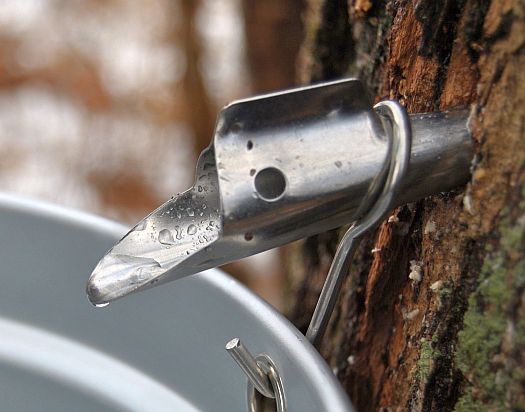Puttin' Up Syrup
by Rod Johnson

A handmade (whittled) spigot, or spile.
You know, some days I swear there's nothing left to tell stories about, as if the larder is empty and exhausted after 70 or so stories. Then, when least expected, a topic untouched for years or unthought of even remotely pops up. Usually, some small event happens or a word is mentioned that rings a bell, and voila, the idea door opens.
Yesterday, it was SYRUP. Yup, you heard me, good old fashion, true forty to one ratio (40:1) AMBER. It happened at breakfast time when my wife Doris slapped down a nice mound of golden pancakes infused with tiny blueberries right within my reach. Then came heaven on earth, so to speak, as she slid over a small crock full of the golden juice.
After the precious mound was admirably disposed of inside my spare tire, thoughts of youthful days poured from the dark recesses of yesteryear. We were young boys of 10 years trudging around the Belgrade Lakes neighborhood in ankle-to-knee-deep spring snow. You know the kind, granular or mealy, at least on the sun-exposed slopes. It was myself, cousin Rickey J., and our tree-house-building buddy Howard Downing. We did most things together and our plan, or scheme, I should say, was to tap maple trees for sap, boil it down to syrup, and sell it. Others had done it in the past and it seemed easy enough.
We quickly learned that like most get-rich-quick ideas, there were roadblocks. For instance, drilling a hole in a tree posed our first problem, then where would we get the spigots? (We called them "spickets," a Maine term I guess, though some call them spiles.) After that someone asked what we'd use for buckets and where would we get them.
To solve all these issues, we turned to our parents of course. Father Clifford agreed to lend us a boring bit, which was an old wobbly bit brace and a dull, ¾", wood bit. He said it had "come home" written all over it. It worked but barely, and we took turns to get the holes more or less 2" deep. This was after our parents instilled in us that we needed to get permission from each land owner.

A modern metal spile, with a metal sap bucket hanging from it.
We had no spickets, so Mother Elsie suggested we make some out of the dead standing bamboo out back of the shed. She had done it as a child for the same purpose and it works. We cut 6" pieces and hollowed out the soft core, then whittled them to fit and drove 'em into the tree hole with a hammer. The last step requires making a small notch to hang your bucket bail on. Neighbor Bunny Tillson later gave us some nice metal ones, which made life easier.
We were getting close now, all we needed was some buckets. This was a collection of anything and everything, mostly metal coffee cans or the bigger soup cans, etc. Plastic was not used in the 1950s to any degree. We punched holes in the top rim and used Dad's stove pipe wire to make bails. Okay, we were in business.
After school each day, we'd stop by a few of the trees and check the daily drippings. Over a few weeks we did gather several gallons of sap and poured it into buckets in our shed, awaiting the day we could boil it down to wonderful pure maple syrup. Well, we had no idea that it would take so much sap to get one pint of the good stuff. Mother's patience, in retrospect, was either commendable or just plain foolish. We practically ruined the kitchen ceiling with condensation droplets hanging from above the stove, where every pan in the house was steaming away.
In the end run, I recall that we had a pint or two of not very pure syrup that we poured over a batch of pancakes that Mom made for us. She then told us in no uncertain terms that any future endeavors of the like would be done in the outdoors.
Dad added that we make damn sure we plugged the holes so the trees wouldn't bleed out their lifeblood! Being normal little ten-year olds, we said we would and didn't. About two weeks later he brought it up again, so we knew he had checked the trees. He made us sit down on the front steps and whittle about 30 plugs, then go drive them in. Oh well, lessons well learned!
Today, when fortunate enough to be consuming Vermont- or Maine-made syrup, there's a certain appreciation that accompanies eating the delectable treat. I will always recall the days of mother's ceiling dripping with sweet condensation.
.Rod Johnson was born and raised in the Belgrade Lakes in the 1950s and '60s.
<— Previous Article • Summaries • Next Article —>
©2020 by Summertime in the Belgrades. All rights reserved.

